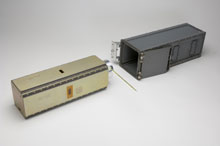NASA GeneSat Shows Small Satellites Can Deliver Big Science

A very small NASA satellite has proven that scientists can quickly design and launch a new class of inexpensive spacecraft -- and conduct significant science. The 11-pound GeneSat-1, carrying bacteria inside a miniature laboratory, was launched on Dec. 16, 2006. It was a secondary payload on an Air Force four-stage Minotaur 1 rocket that delivered the Air Force TacSat 2 satellite to orbit.
GeneSat-1 began to transmit data on its first pass over the mission's California ground station. Scientists still receive data from the satellite regularly.
"GeneSat proves that big science can be done using small satellites," says GeneSat project manager John Hines, an engineer and scientist at NASA Ames Research Center, Moffett Field, Calif. "GeneSat's success points out how NASA can spend less money and time to learn new things in space."
According to Hines, GeneSat-1 is NASA's first fully automated, self-contained biological spaceflight experiment on a satellite of its size. "Based on this success, we expect that in the near future, this class of small satellite will see increasing acceptance and usage by the science community," Hines notes.
These small satellites will help scientists understand the hazards and risks associated with human space travel, Hines believes.
The cost to develop the GeneSat satellite class, launch the first spacecraft and operate it was a fraction of what it normally costs to conduct a mission in space, according to scientists.
Subsequent GeneSat-class missions will cost much less, Hines predicts. Researchers say that knowledge gained from GeneSat-1 will help scientists understand how spaceflight affects the human body. GeneSat-1's onboard micro-laboratory includes sensors and optical systems that can detect proteins that are the products of specific genetic activity.
Biological data returned so far have exceeded the project’s pre-launch success criteria, according to GeneSat-1 lead biologist Macarena Parra. "Throughout the experiment, the temperature remained constant and all systems functioned properly to record our required data," Parra says.
Researchers will further analyze GeneSat-1's on-board systems during the remaining life of the satellite, according to Bruce Yost, the GeneSat-1 mission manager.“We plan to conduct a number of engineering tests and evaluations to increase our confidence in the GeneSat platform," Yost says. "In the next few weeks, we will hand over the GeneSat-1 spacecraft to Santa Clara University, Santa Clara, Calif., for use as a training tool for future aerospace engineers.”
GeneSat-1 will reenter the Earth’s atmosphere and burn up before the end of the year. "Our partnership with the Santa Clara University mission operations team has surpassed all of our expectations with their level of performance and professionalism," Hines says. "This is the first NASA mission to be operated by a student-based team; they worked around the clock and over a holiday break to complete our primary mission. It was a remarkable success," Hines adds.
Bookmark http://universeeverything.blogspot.com/ and drop back in sometime.
Labels: GeneSat, life, NASA, satellite, spacecraft, students


0 Comments:
Post a Comment
Subscribe to Post Comments [Atom]
<< Home